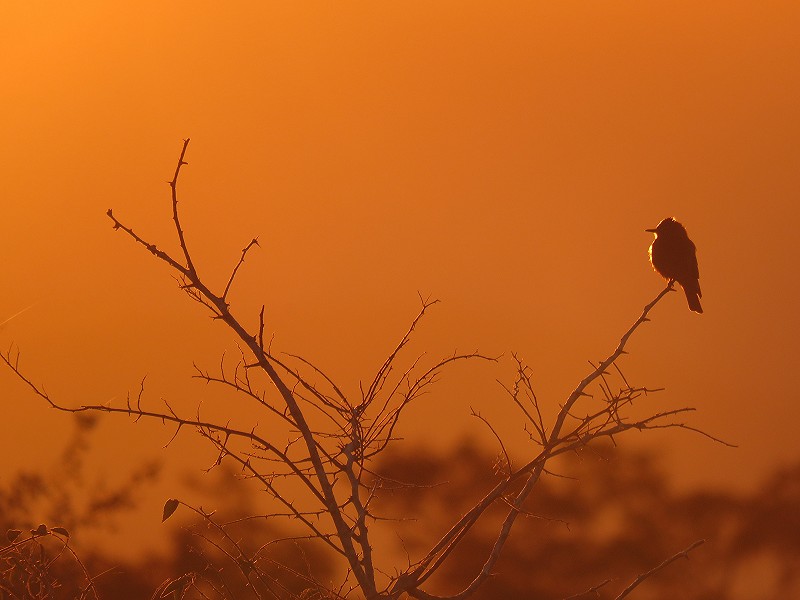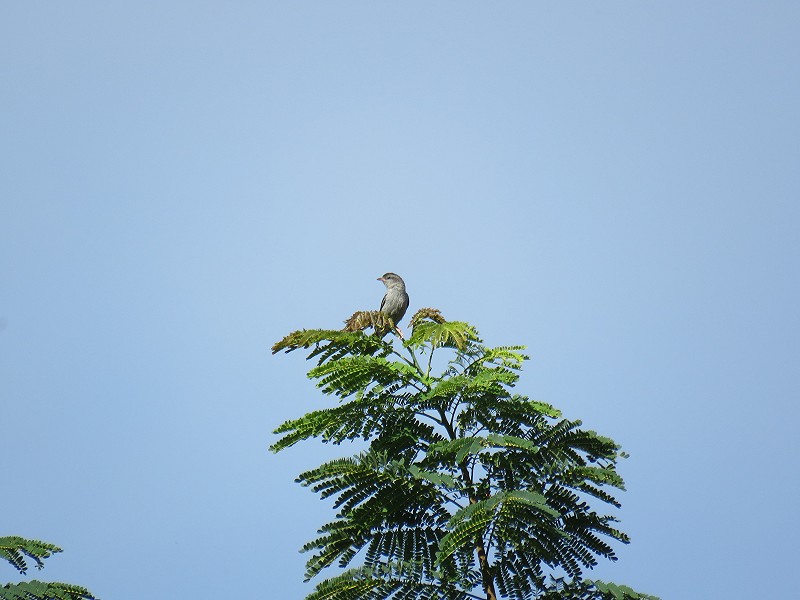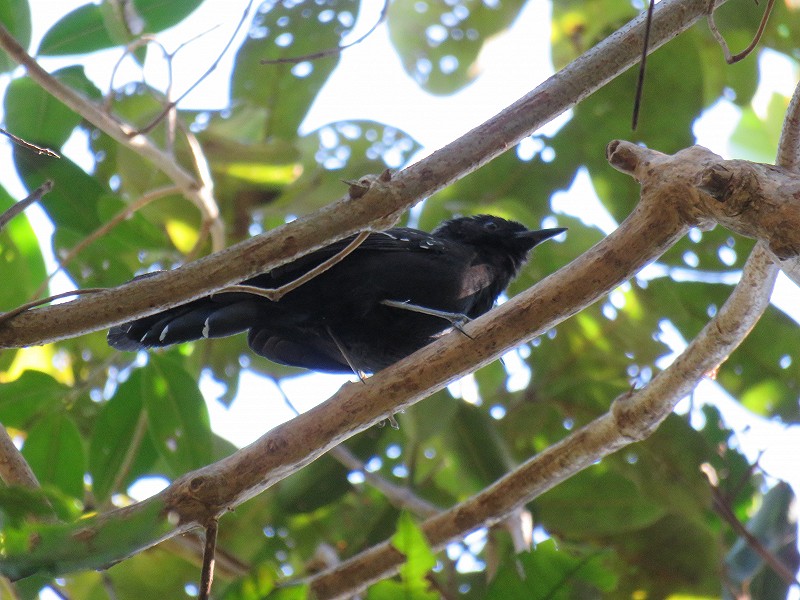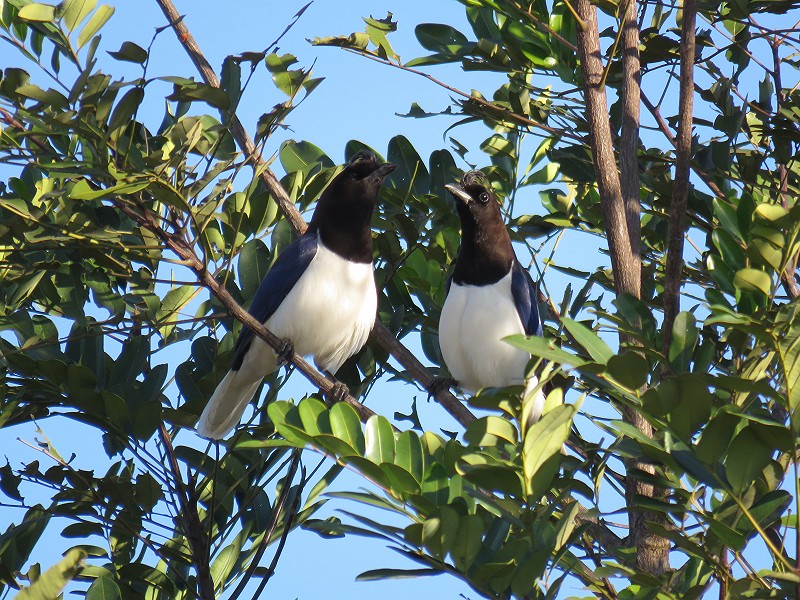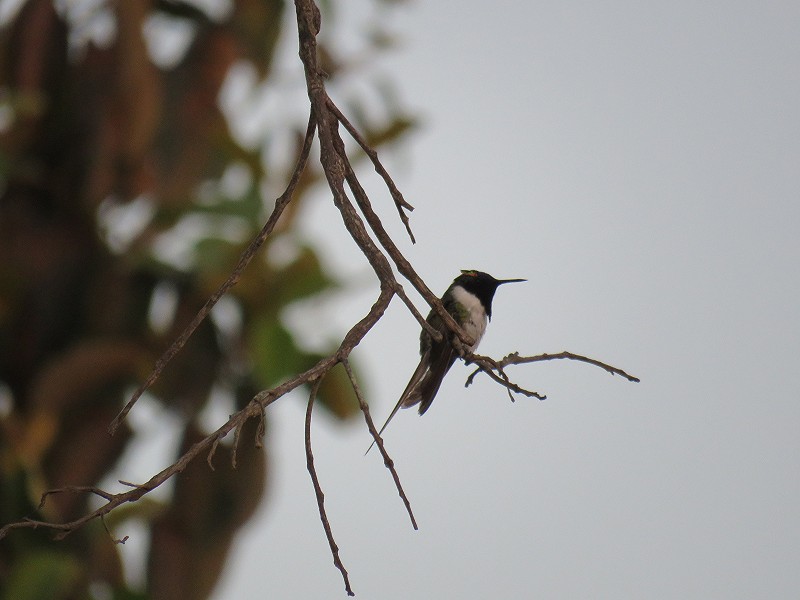July 13 - 20: Brazil (1)
28 July 2016 · Arjan Dwarshuis · 6344 × bekeken
PLEASE MAKE A DONATION NOW!
world.observation.org/arjan
www.arjandwarshuis.com/#biggestyear
July 13th A LONG TRAVEL DAY
Last night I had left Suriname and now I was heading for Boa Nova, Brazil. Before I would get there I would have to make 3 (!) layovers (in Cayenne, Belem and Brasilia). Finally around 4 PM I arrived in Salvador where Ies Goedbloed - my friend and travel companion for the next 5 weeks – was already waiting for me with the rental car. From Salvador we drove more than 450 kilometres southwest to the small town of Boa Nova.
Just before we arrived in our hostal we saw a nightjar on the road that proved to be a fantastic Scissor-tailed. However there was still a mega sighting waiting for us…
As I was checking in Ies heard a soft ‘whoo’ coming from a palm in the middle of the town square. And there – we couldn’t believe our eyes – sat a Stygian Owl!! What a mega start to our 2 days in Boa Nova. Een goed begin is het halve werk, as we say in Dutch!
July 14th ANTBIRD FIESTA
Boa Nova is something special, it is the primary birding locality on a northeastern Brazilian birding itinerary for two reasons; there is good, reasonably well protected wet forest 20 minutes east of town and there is fantastic dry caatinga woodland right at the doorstep of town. Additionaly, there are some very range restricted endangered species that are only found here, most famous being the monotypic Pink-legged Graveteiro.
Today we were on our own, trying to notch up as many specialties as possible, but luckily tomorrow we will have help from local guide Josafa Almeida and his son. When you see the long list of Boa Nova specialties it is easy to understand that we had a huge task at hand – especially since July is possibly the worse time of the year to be here - if we would see the predominant part of them, but we were eager to bird our asses off today :)
We decided to start with the wet forest, walking a small trail known to have nearly all the wet forest-specialties. We had barely parked our car when we hit our first flock and 15 minutes later we had Striated Softail, Bahia Spinetail, Tufted Antshrike, Ochre-faced- and Yellow-lored Tody-flycatcher, Rio de Janeiro Antbird and White-collared Foliage-gleaner in the bag. Wow! We were on a good start.
After feasting our eyes on a very cooperative Least Pygmy-owl it was time to hit the trail. Here it was slow going, not because there were too little birds, on the contrary, we made very little progress because birds were everywhere. And not just your ordinary species. We’re talking about Spotted Piculet, White-eyed- and Buff-fronted Foliage-gleaner, Green-backed Becard, Cryptic Antthrush, Ferruginous- and Scaled Antbird, Sharpbill, Pin-tailed- and Swallow-tailed Manakin, Surucua Trogon and Black-billed Scythebill to name just a few…
After this big success in the wet forest we drove west to the dry caatinga, en route picking up the rare Dubois’s Seedeater.
At the dry forest there was absolutely zero activity during the heat of the day, but I had a plan: ‘let’s start taping in some antbirds’. And so began our afternoon antbird fiesta! In three hours’ time, along a 50 meter stretch of road, we taped in eight species of range-restricted antbirds, in fact all the antbirds that we absolutely needed to see here! We ended our run with Caatinga-, Narrow-billed- and Black-capped Antwren, Slender- and Stripe-backed Antbird and Sooretama Slaty-, Planalto Slaty- and Silvery-cheeked Antshrike and a day total of over 70 species. The predominant part of them being lifer for both Ies and me and all of that without any guiding! Sorry for this unusually lengthy blog, but today was just too awesome :)
July 15th CHASING THE REMAINING BOA NOVA SPECIALTIES
Today we had help of Josafa Almeida and his son. They didn’t speak a word of English, but with help of Google translate and Wi-Fi in our car we could communicate with them. Most importantly they knew their birds really well and at 5 AM we were on are way with our target list.
We started exactly where we ended yesterday and just as the sun rose over the caatinga we were looking at a very showy White-browed Antpitta.
Today was quiet in the dry forest especially since we more or less cleaned up the day before, subsequently it took us three hours to track down Grey-headed Spinetail, Black-bellied Antwren and Stripe-breasted Starthroat.
After a visit to a roost of the range-restricted Pygmy Nightjar in a peculiar rocky landscape dominated by cactuses, we had a quick lunch in Boa Nova and at 1 PM we headed towards the wet forest.
Our main quarry was the rare Fork-tailed Tody-tyrant, a species with a tiny range only found near Boa Nova. I expected a long and probably unsuccessful search during the heat of the day, but as soon as we parked the car we walked into a flock of birds and two minutes later I found a pair of Tody-tyrants, fantastic! Even better – not rarity wise but experience wise – was a Crescent-chested Puffbird feeding on a small black-and-white snake.
Next we drove and hour to the site for the main attraction of Boa Nova, the Pink-legged Graveteiro! After a bumpy drive on a bad road, pushing our rental car to the max, we arrived at the spot and there it was easy. We played a tape and moments later two Graveteiros were singing from the treetops around us!
Our final stop was at after sunset at a small marsh were we watched – and especially heard – several displaying Giant Snipes. This snipe-on-steroids was a fantastic finish to our two days at Boa Nova where we did amazingly well given the short timespan. Now it was time to drive 600 kilometers back to Salvador to catch our early morning flight to Cuiaba, gateway to the Pantanal!
July 16th HYACINT MACAWS, SERIEMA’S AND RHEA’S – PANTANAL BABY!
After a 600 km drive at night, a couple of hours sleep in a chair on Salvador airport and a connecting flight via Brasilia to Cuiaba, we were on our way to the Pantanal, one of the greatest natural wonders on our planet! We were in the very capable hands of Bianca Bernardon, a guide for Birding Pantanal (birdingpantanal.com). Bianca did her Master degree in ornithology on the Mato Grosso Antbird and subsequently she knows the Pantanal intimately well.
The Pantanal is one of the largest floodplains in South America and besides over 500 species of birds it is the best place in the world to see Jaguars, 6 other cat species, Tapirs, Anaconda and Giant Anteaters, and of course huge quantities of Caiman and Piranha.
As we drove out of Cuiaba and into the Pantanal it was cloudy, windy and cold; a ‘cold spell’ had arrived. With cool weather blowing in from the southeast the temperature had dropped more than 10 degrees. Hopefully this wouldn’t affect our birding too much…
We started well with a fantastic pair of Hyacint Macaws nesting in a roadside tree. Wow, what a fantastic experience to see the largest parrot in the world!
After we’d checked in at the wonderful Piuval Lodge we went birding on the floodplain and in some forest patches, but the unusually cold weather made things difficult. Still we finished the day with two new bird families for me, the incredible Red-legged Seriema and the ostrich-of-the-new-world, the Greater Rhea. Best however was a pair of Bare-faced Curassows and a pair of the rare Chestnut-bellied Guan. We had done incredibly well on the Pantanal’s unique mega fauna, the main reason for a birder to come to this amazing place.
July 17th THE PANTANAL EXPERIENCE!
When we woke up this morning it was still more chilly than usual in the Pantanal, but the wind and the clouds were gone, ideal conditions if you’re planning to bird all the way through midday. Yes Bianca had grand plans, after our morning birding session in the woodlands surrounding Piuval we would drive all the way to the Porto Jofre fields, more than 100 km further south in the Pantanal.
The morning session was splendid with Greater Rheas and Red-legged Seriemas patrolling the fields in the distance and Jabirus and Limpkins dotted across the horizon. We were in the Pantanal!
After a quick snack we started heading south, deeper into the Pantanal floodplain and as we made steady progress across the Transpantanaria the landscape got wetter and wilder. Before we knew it we felt like being in a BBC documentary. Everywhere were Kaimans and water birds, in huge quantities, exactly how I’d imagined the Panatanal.
The best bird we got en route was a smashing Scarlet-headed Blackbird, but the absolute highlight was a Giant Otter Bianca found on call (she heard a baby otter yelping from its borrow under one of the many Transpantanaria bridges, after we waited for a while the mother appeared)!
Around the Porto Jofre fields we found several quality birds like Subtropical Doradito, Southern Scrub Flycatcher, White-bellied Tyrannulet and Sungrebe.
When it got dark we drove back north to the Porto Jofre hotel when suddenly there was a cat crossing the road, an Ocelot! Today we experienced that true Pantanal feeling everybody who's been there talks about…
July 18th FROM THE FLOODPLAIN TO THE CERRADOS
Already our last morning in the Pantanal wherein we had both a boat trip and a trail planned. We started with a pre-breakfast hour of birding on the Porto Jofre airstrip that produced a very cool Collared Forest Falcon.
On the river we got lucky with a flock of Nanday Parakeets and for Ies a lifer Boat-billed Heron and a very showy Sungrebe, another classic set of Pantanal specialties. At the end of the boat ride we were dropped at the far end of a loop trail, which begins behind the Porto Jofre hotel. Our main quarry here was Bianca’s Master degree study subject, the enigmatic Mato Grosso Antbird. These beatiful jet black antbirds are luckily quite common and shortly after we set foot on the trail we found a pair followed not long thereafter by another special, the Band-tailed Antbird.
After checking out at the Porto Jofre Hotel we left the Pantanal and headed for the dry cerrados of Chapada dos Guimaraes!
Itineraries are short and effective when on a big year, but I will surely come back to the amazing Pantanal to look for Giant Anteaters, Jaguars and Pumas!
July 19th WORKING HARD FOR HARD BIRDS
When we woke up this morning at the Pousada Cambara it was windy and cold, but luckily there was the most elaborate home made breakfast I’d ever seen waiting for us. After this feast we drove to our first birding locality in the dry cerrados. This forest type is under huge pressure from logging and burning to make way for agriculture and subsequently birds are suffering, especially the rare Yellow-faced Parrot. Once a common sight in central Brazil this species has become very rare over the course of the last decades and sightings of this enigmatic parrot have become irregular around Chapada dos Guimares. In fact they are hardly ever found on regular birding itinerary any more. Naturally we were hoping, just a little bit, that we would see one…
We had to work hard to find good birds in the cerrados because the cold windy conditions meant that there was very little activity. Still we started well with a smashing male Horned Sungem - one of our main targets - and a fantastic perched Orange-breasted Falcon, but after a full morning of birding we had seen just a hand full of cerrados specialties. Would the afternoon bring the game-changer we were longing for?
We had lunch – prepared by her father who practices Agua Farming (a much needed form of sustainable farming that will one day incorporate agriculture in forest conservation) - at Bianca’s home on a ranch surrounded by beautiful riverine forest and it was here after lunch that we had our game-changer in the form of a Small-billed Tinamu followed quickly by a Sharp-tailed Streamcreeper foraging on rocks on the stream that runs through the property. Great!
Indeed the afternoon was much better with Shrike-like Tanager, some more Horned Sungems and best of all a male Blue Finch. Then it happened, in the dying seconds of the day… I saw a Parrot approaching from the right with perfect light in the back. I yelled ‘Parrot’! We lifted our bino’s and there was a Yellow-faced Parrot showing incredibly well as it flew by 3 stunned observes. A glorious big day moment…
July 20th ON TO THE RIO AZUL!
Already our last morning in the cerrados and after our big day yesterday there were few targets left, almost all of them hard to find species. Our main target was the Collared Crescentchest, an unusually stunning Tapaculo species and a true cerrados specialist. Luckily we received spot-on site info from three Ecuadorian birder who also stayed in the Pousada Cambara and who had seen this bird the day before. The info proved spot-on indeed because right at dawn we found the Crescentchest singing on top of a small bush, great and thank you guys!
Other good birds were Rufous-winged Antshrike, White-eared Puffbird, White-rumped Tanager and several displaying Chapada Flycatchers, a recently described species.
Then it was time to say goodbye to Bianca and thank her for a fantastic and highly successful five days. Thanks Birding Pantanal for putting this crazy itinerary together and for anyone planning to visit this incredible birding hotspot, please go to www.birdingpantanal.com.
On to the Rio Azul!
Arjan Dwarshuis
PLEASE MAKE A DONATION NOW!
world.observation.org/arjan
www.arjandwarshuis.com/#biggestyear
Discussie
Eduard Sangster
·
30 July 2016 10:26
Superbestemmingen! Pantanal is wat mij betreft de beste wildlife ervaring na de Afrikaanse wildparken. Boa Nova is waanzinnig birden. Arjan heeft nu in 7 maanden net zoveel soorten gezien als ik in mn hele leven. Gelukkig heb ik tussendoor wat meer geslapen :) Hou vol Arjan, je doet het geweldig! Leuke stukjes schrijf je ook.
Gebruikers van het forum gaan akkoord met de forumregels.


